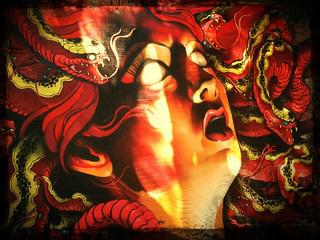Origins of Medusa
Medusa, originally a beautiful priestess devoted to Athena, pledged her life to celibacy. Stationed in Athena's temple, she embodied purity and religious fervor. Her dedication was tested when Poseidon assaulted her within the sacred walls meant to protect her chastity and spiritual commitments.
The aftermath was catastrophic for Medusa. Athena, enraged by the desecration of her sacred space, cursed Medusa, transforming her golden locks into venomous snakes and her admirable gaze into a petrifying weapon. Athena's curse stripped Medusa of her beauty and humanity.
This transformation highlights societal double standards regarding purity, female victimhood, and the complex power dynamics among the divine. Medusa's curse embodies betrayal and injustice, with her monstrous exterior mirroring the cultural and divine betrayals she endured.
Medusa's tale begins with victimhood, framed by celestial and societal structures that underscore the tragic irony of her fate. Her story reflects on the intersection of divinity, power, and gender, setting the stage for understanding victim-blaming and female agency in Greek mythos.
Medusa's Curse
Caught in a divine feud, Medusa found herself thrust into the devastating tangle of Poseidon and Athena's rivalry. The traumatic encounter posed profound questions about divine morality and the power games played at the expense of mortals.
As Poseidon receded with impunity, Athena turned to Medusa. The transformation served as a reminder that divine protection could warp into punishment. The symbolism mirrors contemporary debates about institutional powers misdirecting their might at victims rather than aggressors.
The curse placed on Medusa is steeped in the realization of unimaginable loss: her agency, dignity, and narrative. From her pain stemmed a hazardous power that would forever mark her myth. Medusa's eyes turned weapons were both a curse and a protective armor, preventing further harm but at the cost of isolation and fear. She became revered and reviled, encapsulating a state of perpetual conflict reflecting women's surviving narratives against violence.
Medusa's story invokes us to question moral and philosophical dilemmas about blame and retribution. Why do we direct our displeasure towards victims of injustice rather than perpetrators? These questions thread through the fabric of everyday societal injustices faced by countless across ages and civilizations.
As her being evolved into something formidable, the negative portents connected with Medusa starkly opposed her origin story as a victim turned protector with lethal sight. In the grand amphitheater of Greek mythology, Medusa's tale enduringly resonates as a lesson in misplaced blame and the complexities of vengeance injected justice.
Viewed through the prisms of oppression, power dynamics, and changeable loyalties, Medusa morphs from a character in cautionary tales into a symbol of enduring strength in adversity. She challenges us to look beyond appearances and delve into the stories etched beneath, reminding us that sometimes, behind what's terrifying hides a tale more tragic than frightening.

Symbolism of Medusa
The snake, as a symbol, carries paradoxical representations—rebirth and death, healing and poison. In Medusa's tale, the serpents twisting through her locks were not just threads of punishment, but of symbolism that cast a shadow on Greek society's notions of fear, purity, and vindictiveness. The snaking hair brings forth the imagery of eternal vigilance, always alert to threats, ever-protective of the bearer. This transformation from revered beauty to feared Gorgon encapsulates a brandished badge of authority, terrifying yet regal.
These serpents also hovered as guardian figures warding off evil—a frequent iconographic slate across Grecian armor and temples. Medusa's stone-inducing gaze adds another layer, meshing indifference with enforced isolation. This look turned sword carries the primal fear of mortality mixed with the Greek inclination towards the celebration of corporeal aesthetics and glory. To lose one's ability to gaze upon beauty or be beheld in return was like living diminished yet aware, piling on Medusa's tragedy.
The rigor mortis of her gaze also pushes a thread through patriarchal molds where women's roles were often contained—objects placed on pedestals or concealed away. Medusa's condition could echo this liminal female societal placement: having eyes but deemed dangerous when met with directness. The crux is reflective—the suffering inscribed beyond pathos for a woman triumphed and terrorized by her narrative's tormentors.
It's interesting to contemplate why the dread-inducing image of Medusa was harnessed as a protective totem. Ancient artisans wrought her countenance into shields and breastplates, stamping her across doorways and walls. This curious turn from abject horror to a shield against it perhaps reflects acceptance in carrying fears on one's chest, seeing a constant reminder of sublime terror to divert other malignant forces. The artifacts can be read as talismans converting anxieties into empowerment.
Furthermore, maybe that's what still captivates us—not just a relic of ancient fascination with horror and veneration but resonating with existing struggles, individual exits from monstrous metamorphoses spun out of conditional severities imposed socially. With every protective deployment in Grecian lore, Medusa transfixes: as emblem, as wielded weapon, as symbol culminating in dual shards of avenging fright and defensive might.
Medusa in Art and Culture
Medusa has transcended her mythological roots and ventured into art, literature, and media, brewing a complex blend of terror and triumph. From antiquated stone carvings to pixel-perfect animations, her image captivates creatives today as much as ever. Each rendition showcases artistic trends and reveals evolved public ethos towards this gorgonian figure.
In ancient Greece, images of Medusa depicted a grotesque creature with a broad face, matted with venomous serpents for hair and jutting tusks. Such depictions on artifact shields served as talismans believed to ward off evil. Fast forward to the Renaissance, artists like Caravaggio took liberty to paint Medusa's head with sympathy, capturing both horror and a silent scream of despair, touching upon a tragic undertone.
Renaissance artists pushed to analyze Medusa beyond appearance. Within their frames coupled with potent emotionality, one ceases to see merely a monster, but benchmarks the feeling of indignation toward the tragedy of her story—a shift echoing burgeoning empathy in societal contexts toward 'victims.'
This nuanced understanding courses into modern portrayals. Literary figures like Percy Bysshe Shelley or contemporary movies oscillate between reverence and revulsion, puzzling out strands of Medusa's existential lock. Far from straightforward personifications of evil, modern Medusa often receives a backstory probing into themes of justice, assertiveness versus aggression, and notions of beauty interlinked with terror.
Medusa's visage strikes a chord in pop culture, symbolizing depth wrapped in dread. Heard in invigorating rhythms or viewed in clever animated antics, Medusa illustrates an evolved intersection of repulsion and fascination society holds against nuances in narratives blurred between villainy and victimhood.
Embracing this emblem of transformation, luxury brands like Versace engrain Medusa within high fashion. Here, her head transforms into a mark of elegance and defiance—a dramatic pivot from her folklore origin.
Threading through shades of Medusa's artistic and cultural legacy prompts contemplation about how myth turns into social conversation about resilience, injustice, or spectacular metamorphosis. Each portrayal explores what it means to face 'the monstrous,' reflecting society's shifting affirmations and anxieties decoded over time. As viewers, scholars, or simply as humans 'myth-taken' by her narrative, we're driven to explore deeper truths hinted at beneath every image that captures her spellbinding stare.

Medusa's Legacy
Medusa's narrative undulates beyond her mythic origins into modern discourse, rising as both a symbol of the victim and the vindicated. Perceived through feminist interpretations, she epitomizes the shift from disempowered to potent symbol of resistance against gendered oppression. These currents flow within the #MeToo movement, where her story resonates with narratives of sexual assault survivors, structuring dialogues around consent, victim-blaming, and reclamation of agency.
Psychologically, Medusa's transformation and terrifying attributes can be interpreted as a shield, forcibly donned in the aftermath of trauma—a metaphor for strategies used by survivors to protect their vulnerability. Her once paralyzing beauty turned frightful might parallel the defenses raised by those who, having been harmed, fortify themselves against further violation. This conversion from victim to cornered creature channels a compelling dialogue around the armor survivors wear, often misinterpreted as coldness or detachment.
Athena's response underscores ancient narratives of victim-blaming. Medusa's tale enriches the #MeToo discussion on how society often punishes or ostracizes survivors instead of offering support and seeking justice. Coming to grips with these nuances can evoke discomfort. It forces reflection on the shared cultural script that frequently scrutinizes the victim and feeds skepticism which, like Medusa's snake-ridden head, can freeze potential support in its tracks.
Feminist re-readings have interpreted Medusa not as a monster to invoke terror, but as an icon battling against the perpetuation of male violence. Artists and activists have refashioned Medusa as a figure of defiance. An illustrative pivot marks the 2018 artwork in which Medusa stands over the slain body of Perseus—the narrative reversed, proffering an image of justice reclaimed.
Further stimulating these discussions is Medusa's adoption in psychology as emblematic of rage turned inward—an allegory representative of conditions resulting from prolonged exposure to traumatic stress. The frayed symptoms mirroring Medusa's visage articulate how trauma can transmute physical and emotional attributes as individuals host this imposed beast.
Including her in popular media about ongoing systemic failures to protect assault victims, Medusa now postulates a complex convergence where folklore meets feminist protest. Her story brings forth insights embodying despairing narratives turned forward-looking allegories of awakening.
By weaving Medusa into discussions around patriarchy, power, and persecution, we reclaim more than misconstrued narratives; we nourish a myth with potentialities for rewriting and reconciliation. Activists engage with her legacy intent on remembering and rectifying, steeping her sands in new spirits matching today's demands for justice. Medusa shines a beacon on the strength one embeds against adversities, having wielded pain into sharp-eyed survival strategies—even as societies shift from observance to rectification concerning victims' plights.
Medusa's legend metamorphoses—atrocity analyzed not only for its articulation of ancient grievances but vivified amid contemporary claims for recovery and recast rights over individual narratives. Engaging with her enduring narrative does more than uncover old myths; it establishes fiercer foundations fostering expanded empathies, acting not just as echo but enticing revolutions rekindled amidst rallying resonances. This lays fertile ground where new understandings materialize, amended amid stirring stances shimmering in societal spaces once shadowed yet now beckoned to revise decaying discussions around apparent villainy, rendering rightful restorations regarding dialogues pertaining to dominations once dire turned daringly diverse. In the retelling, supporters strew seeds sprung forth in flexibility, daring declarations to devise differing directions through previously dimmed dominations, discernibly dictating Medusa's metamorphosis merging.

In the tapestry of Greek mythology, Medusa's narrative stands out for its potent symbolism of resistance against injustice. Her transformation from victim to emblematic figure of defiance continues to resonate, offering insights into the struggles and resilience that define human experience across ages.
- Dexter, Miriam Robbins. "The Ferocious and the Erotic: 'Beautiful' Medusa and the Neolithic Bird and Snake." Journal of Feminist Studies in Religion 26, no. 1 (2010): 25-41.
- Johnston, Sarah Iles. "Defining the Dreadful: Remarks on the Greek Child-Killing Demon." In Ancient Magic and Ritual Power, edited by Marvin Meyer and Paul Mirecki, 361-387. Brill, 2001.
- Joplin, Patricia. "Medusa: Mirrors, Masks, and Monstrous Metaphors." Soundings: An Interdisciplinary Journal 76, no. 2/3 (1993): 225-245.
- Wilk, Stephen R. Medusa: Solving the Mystery of the Gorgon. Oxford University Press, 2007.

Leave a Reply